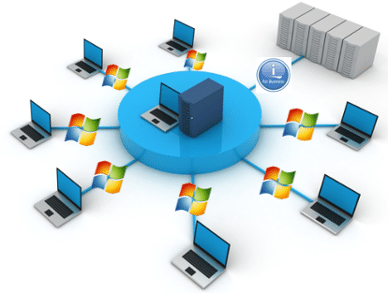 For CIOs who may not be familiar with the IBM i environment, it helps to understand how you can leverage an IBM i system in a Microsoft Windows network.
For CIOs who may not be familiar with the IBM i environment, it helps to understand how you can leverage an IBM i system in a Microsoft Windows network.
IBM i partitions can run most TCP/IP servers alongside production software. Many packages, including DRV’s full-line of solutions, can run IBM i and TCP/IP servers on the same partition, rather than using Windows servers for standard TCP/IP functions.
This can help Windows managers decide three things when delivering IBM i-produced stream files to users:
1) Whether to place new IBM i-based traffic on existing Windows servers
2) Whether to stage new Windows servers to handle additional IBM i traffic
3) Whether to use native IBM i TCP/IP functionality
Here’s how IBM’s native TCP/IP capabilities provide options in a Windows network to reduce traffic, use your IBM i as a Microsoft file server, and avoid additional Windows server costs.
Choices, Choices, Choices
Like a Windows server running VMWare, you can create multiple IBM I, AIX, and Linux partitions on an IBM Power server box.
But where most Windows shops only run a few applications on each virtual partition or physical server, IBM i shops usually run all their IBM production applications on the same partition.
The Windows applications/partition ratio is low (around 1-3 applications per partition), but the IBM i applications/partition ratio is high. Because of its architecture, you can run as many applications on an IBM i partition as you have resources to support them with. It’s common for IBM i shops to run 20+ applications on a single partition.
Because of the IBM I multi-application architecture, you have more options for exchanging information using TCP/IP in a Windows network. You can use Windows TCP/IP servers or native TCP/IP IBM i servers, and you can use whichever server best meets your needs.
Here are some ways IBM i TCP/IP services can help you move information in a Windows network.
Providing Windows Drive Mapping for IBM i Data
Using applications such as DRVTech’s report automation and document management software, you can save IBM i application output in universal file formats such as PDF and XLSX. These files can be directly written to a Microsoft file server using QNTC, the IBM i Server Message Block (SMB) client.
You can also save application output to the IBM i Integrated File System (IFS), which has the ability to store stream files and make them available through a Windows file share. Once stored to the IFS, your Windows users can access those files by mapping a drive to the IFS through their Windows desktop Computer folder.
Using the IFS in lieu of a Windows file server can save Windows storage on your existing server (avoiding a possible Windows file server upgrade). You may also potentially save another Windows server license if you would need to stage another Windows server to handle your IBM i stream file traffic.
For more information on using the IFS as a Windows file share, see my earlier post on sending IBM i report data directly to Windows servers and to your users.
Reducing Traffic on Your Exchange Servers
You can configure the IBM i SMTP server to forward email to a Microsoft Exchange Server or you can set up an IBM i SMTP server to do the job. Most IBM i packages that use email services can be configured to use either a Windows or an IBM i SMTP server. If you don’t want to add extra traffic to your Exchange servers or the Exchange servers reside in a different network, you may want to send IBM-generated emails directly through the IBM i native SMTP server.
And There are More Options
SMTP and SMB aren’t the only TCP/IP options you have available on an IBM i. You can leverage your IBM i systems to natively run most TCP/IP services, including:
- Domain Name Server (DNS)
- Dynamic Host Configuration Protocol (DHCP)
- Apache HTTP server
- Lightweight Directory Access Protocol (LDAP)
- Line Printer Requester and Line Printer Daemon (LPR and LPD)
- Quality of Service (QoS)
- Simple Network Time Protocol (SNTP)
The Choice is Yours
My purpose here isn’t to recommend running all your native TCP/IP servers on IBM i. If it meets your business needs for configuring IBM i software from DRVTech or other vendors, you can run TCP/IP functions on either an IBM i or on a Windows server.
IBM Power systems running IBM i partitions give you more options to leverage both your IBM i and your Windows servers by: reducing network traffic, reducing your Windows licensing charges and the number of Windows servers, and using your IBM IFS as a Windows file server. Don’t forget your free eguide by clicking the button below, as well as the helpful articles we’ve included for your viewing.
Click the button below to get your comprehensive paperless reporting and IBM i eGuide
More articles on IBM i concepts and the Windows world
3 Steps for Moving Spooled Files Out-of-Machine for Non-IBM i Managers
Four Keys to Fair Software Pricing
IBM i Software Pricing for Non-IBM i Managers
Translating IBM i for the Windows World
JUL
